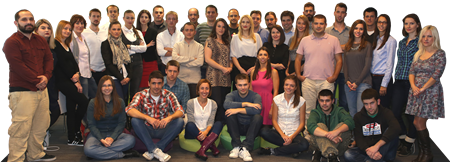Visceral Afferent Functions of the Nervous System
| Cena: |
| Stanje: | Polovan bez oštećenja |
| Garancija: | Ne |
| Isporuka: | Pošta CC paket (Pošta) Post Express Lično preuzimanje |
| Plaćanje: | Tekući račun (pre slanja) Lično |
| Grad: |
Beograd-Zvezdara, Beograd-Zvezdara |
ISBN: 0713142278
Godina izdanja: 1974
Jezik: Engleski
Oblast: Neurologija
Autor: Strani
Percival Peter Newman - Visceral Afferent Functions of the Nervous System
Edward Arnold, 1974
273 str.
tvrdi povez
stanje: dobro otpis iz biblioteke, Ex-library.
CONTENTS
1 Introduction
Experimental methods
General management Stimulation Recording
Analysis of results Organization of the visceral afferent system Histological aids 11
Idea of a `visceral brain`
2 Visceral sensibility
Visceroceptors
Types of fibres
Splanchnic nerve compound action potential
Pathways of afferent fibres in the splanchnic nerves
Afferent pathways from the large intestine
Afferent pathways from the urinary bladder
Sensations from the abdominal viscera
Summary
3 Visceral reflexes mediated by the spinal cord
Changes in arterial blood pressure
Viscero-motor reflexes
Splanchnic afferent pathways
Dorsal horn 41 Spinal interneurones 41 Dorsal
columns 42 Ventrolateral columns 43
Visceral reflexes from pelvic organs
Summary
4 Visceral afferent representation in the cerebellum
Experimental methods
Anaesthesia 55 Operative and recording
procedures
Projection area in the anterior lobe
Stimulation of abdominal viscera
Stimulation of the splanchnic nerve
Interaction between cutaneous and splanchnic afferents
Primary waves 69 Single units 69
Discussion
5 Ideas on cerebellar function
Structure of the cerebellum
Functional arrangements in the cerebellum
Mossy fibre input 82 Climbing fibre input 86
Outflow from the cerebellum
Interpretation of events
Summary
6 Visceral functions located in the brain stem
Cardiovascular and respiratory responses to heating A heat-sensitive region in the medulla 110
Alimentary reflexes
Control of the urinary bladder
The inferior olive:
Descending functional pathways-basal ganglia
Sensorimotor cortex 123 Orbital cortex
The reticular formation:
Effects of stimulating the splanchnic nerve
7 Visceral projections to mid-brain and thalamus
The oculomotor mechanism
Pupillary dilatation 137 Pupillary constriction 139
Visceral responses in the thalamus
Role of thalamus in visceral sensation 145
Problem of referred pain 149 Inhibition of pain 150
8 Viscero-sensory areas in the cerebral cortex
Experimental methods
Responses to visceral distension
Responses to stimulation of the splanchnic nerve
Responses of single cortical units
General considerations 161 Properties of the evoked
response 162 Comments 169
Interaction between cutaneous and splanchnic afferents 172
The second sensory area
Corticofugal influences on the visceral input
Cortico-thalamic relay system
Summary
9 The orbital cortex
Viscero-sensory inflow
Vagal afferent responses 185 Splanchnic afferent responses 188
Influence on alimentary system
Stimulation, gastric movements and secretions 193 Ablation, experimental and clinical evidence 196
Influence on cardiovascular and respiratory systems
Mechanism of cortical control 200
Influence on blood pressure response to heating 202
Orbito-medullary pathway
Conclusions
10 Cerebral control of hypothalamus
Anatomical divisions
Functional divisions
Orbital cortex and hypothalamus
Anterior cingulate and hypothalamus
The temporal lobe and hypothalamus
Influence of the hippocampus 226 Influence of the
amygdaloid 234 Functional interpretations 240
Emotional reactions
Summary
11 General conclusions
Author index
Subject index
Common terms and phrases:
abdominal action activity afferent afferent fibres amygdaloid anaesthesia animal beta bilateral bladder blood pressure body brain stem caused central centres cerebellar cerebellum cerebral cortex changes cingulate climbing fibre complete conditioning conduction convergence cortical cutaneous demonstrated described discharges distension distribution dorsal effects electrical stimulation electrode evidence evoked excitatory excited experiments firing functions give Golgi cells gyrus heating hippocampus hypothalamus important impulses increased influence inhibition inhibitory intensity interaction intervals involved latency lateral localized means mechanisms method movements msec muscle neurones Neurophysiol nucleus observed occurs olive orbital cortex organization origin pain pathways peripheral Physiol points positive posterior potentials primary probability produced projections Purkinje cells reach reactions recorded reflex region relay reported responses reticular rise role sensory single somatic spike spinal cord splanchnic afferents splanchnic nerve stimulation stomach structures studies suggested surface temperature terminate testing thalamic trace tract unit vagal visceral wave
0713142278 , Monographs of the Physiological Society
Plaćanje pouzećem i postnetom za sada nisu opcija.
Lično preuzimanje je isključivo na Konjarniku uz prethodni dogovor.
Hvala na razumevanju.
Predmet: 82433829











